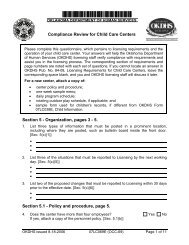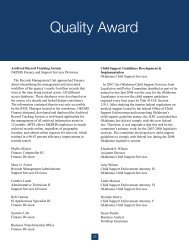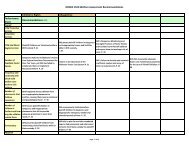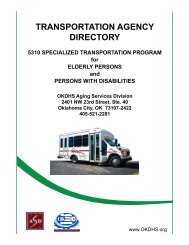The Oklahoma Pinnacle Plan - Oklahoma Department of Human ...
The Oklahoma Pinnacle Plan - Oklahoma Department of Human ...
The Oklahoma Pinnacle Plan - Oklahoma Department of Human ...
You also want an ePaper? Increase the reach of your titles
YUMPU automatically turns print PDFs into web optimized ePapers that Google loves.
<strong>The</strong> <strong>Oklahoma</strong> <strong>Pinnacle</strong> <strong>Plan</strong>:<br />
An Improvement <strong>Plan</strong> for Child Welfare Services<br />
APPENDICES<br />
March<br />
2012<br />
Because children in the Child Welfare System have a significantly higher likelihood than the general<br />
population <strong>of</strong> experiencing multiple ACEs, the <strong>Oklahoma</strong> Child Welfare service community has actively<br />
embraced the vision <strong>of</strong> <strong>Oklahoma</strong> becoming a Trauma Informed Child Welfare System. A Child Welfare System<br />
that recognizes and responds to childhood trauma and provides services in a Trauma-Informed manner<br />
allows individuals who are exposed to ACEs the opportunity to heal and change a trajectory that may<br />
otherwise lead to long-term health and mental health problems as well as other social ills. A Trauma-<br />
Informed Child Welfare System that addresses childhood trauma as early as possible can achieve better<br />
overall outcomes, resulting increased Safety, Permanency, and Well-being.<br />
A Trauma-Informed Child Welfare System is one in which all parties involved recognize and respond to<br />
the varying impact <strong>of</strong> traumatic stress on children, caregivers and those who have contact with the<br />
system. Programs and organizations within the system infuse this knowledge, awareness, and skills into<br />
their organizational cultures, policies and practices. <strong>The</strong>y act in collaboration, using the best available<br />
science, to facilitate and support resiliency and recovery. iv<br />
<strong>Oklahoma</strong> has embarked on a process to transform the child welfare system into a Trauma-Informed<br />
System. <strong>The</strong> work in <strong>Oklahoma</strong>’s Child Welfare System is consistent with a national focus and initiatives<br />
to identify and address childhood trauma within the Child Welfare System. It serves as an integral part<br />
<strong>of</strong> delivering effective Child Welfare services and seeks to assure that those services have a positive<br />
impact on children’s development and on families served. In August 2010, it was announced that the<br />
<strong>Oklahoma</strong> <strong>Department</strong> <strong>of</strong> <strong>Human</strong> Services child welfare system was selected as a lab site for the<br />
Chadwick Trauma-Informed Systems Project (CTISP), www.ctisp.org.<br />
Goals<br />
<strong>The</strong> goals <strong>of</strong> the CTISP and the goals <strong>of</strong> the <strong>Oklahoma</strong> Implementation <strong>Plan</strong> are the same. <strong>The</strong>y are that<br />
Trauma-Informed Child Welfare Systems will understand how:<br />
child and family resiliency after trauma can be enhanced;<br />
current and past trauma impacts the families with whom child service workers interact;<br />
adult trauma interferes with adult caregivers’ ability to care for and support their children;<br />
vicarious trauma impacts the child-serving workforce;<br />
exposure to trauma is part <strong>of</strong> the child welfare job;<br />
trauma has shaped the culture <strong>of</strong> the child welfare system, the same way trauma shapes the<br />
world view <strong>of</strong> child victims; and<br />
Trauma-informed systems integrate a range <strong>of</strong> evidence-based and trauma-specific treatments and<br />
practices supported by the NCTSN. v<br />
Based on the Unique Community Pr<strong>of</strong>ile completed by Chadwick with <strong>Oklahoma</strong>, recommendations<br />
were identified to identify interventions and resources and to build on <strong>Oklahoma</strong>’s recognized<br />
strengths. Senior Leadership within the <strong>Oklahoma</strong> <strong>Department</strong> <strong>of</strong> <strong>Human</strong> Services and partnering<br />
<strong>Oklahoma</strong> child serving systems have expressed and provided support to the stated goals <strong>of</strong> the CTISP<br />
Implementation. This is evidenced by the identification <strong>of</strong> staff to serve on the steering committee,<br />
provide internal agency leadership and provide input to the development, review and Trauma Informed<br />
Care work. Continued Senior Leadership support is anticipated crucial to the ongoing success <strong>of</strong> this<br />
plan. <strong>Oklahoma</strong>’s Implementation <strong>Plan</strong> for a transformation to a Trauma-Informed Child Welfare<br />
System includes initial roll-out to six lab sites (Jackson/Greer, Custer, <strong>Oklahoma</strong> 55 A, Pontotoc,<br />
Appendix C – Trauma-Informed System Implementation <strong>Plan</strong><br />
- 18 - | P a g e
















